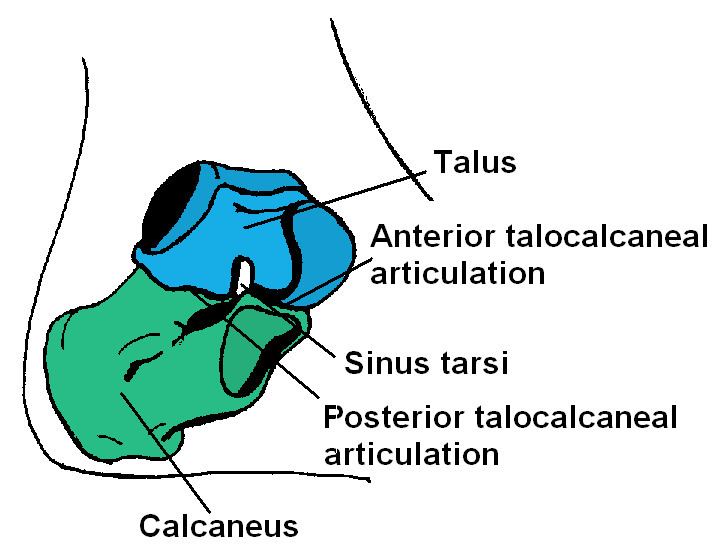Dorlands/Elsevier a_64/12161574 FMA 35198 | TA A03.6.10.101 | |
 | ||
Latin Articulatio subtalaris,articulatio talocalcanea MeSH A02.835.583.378.831.780 | ||
In human anatomy, the subtalar joint, also known as the talocalcaneal joint, is a joint of the foot. It occurs at the meeting point of the talus and the calcaneus.
Contents
Structure
The talus is oriented slightly obliquely on the anterior surface of the calcaneus.
There are two points of articulation between the two bones: one anteriorly and one posteriorly:
The subtalar joint contributes to 10% of dorsiflexion of the ankle. There are three articulating facets between the talus and the calcaneus, delineated as the anterior, middle and posterior facets. The sustentaculum tali forms the floor of middle facet, and the anterior facet articulates with the head of the talus, and sits lateral and congruent to the middle facet. The posterior facet is the largest of the three, and separated from the others by the tarsal canal.
Ligaments and membranes
The main ligament of the joint is the interosseous talocalcaneal ligament, a thick, strong band of two partially joined fibers that bind the talus and calcaneus. It runs through the sinus tarsi, a canal between the articulations of the two bones.
There are four additional ligaments that form weaker connections between the talus and calcaneus.
A synovial membrane lines the capsule of the joint, and the joint is wrapped in a capsule of short fibers that are continuous with the talocalcaneonavicular and calcaneocuboid joints of the foot.
Function
The joint allows inversion and eversion of the foot, but plays no role in dorsiflexion or plantarflexion of the foot.
It is considered a plane synovial joint, also commonly referred to as a condyloid joint.
The subtalar joint can also be considered a combination of the anatomic subtalar joint discussed above, and also the talocalcaneal part of the talocalcaneonavicular joint. This is the more common view of the subtalar joint when discussing its movement. When both of these articulations are accounted together, it allows for pronation and supination to occur.
Pathology
The subtalar joint is particularly susceptible to arthritis, especially when it has previously been affected by sprains. Symptoms of subtalar joint arthritis include pain when walking, loss of motion through the joint's range of motion, and difficulty walking on uneven surfaces. Physical therapy, orthotics, and surgery are the main treatment options.
